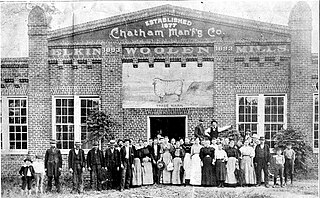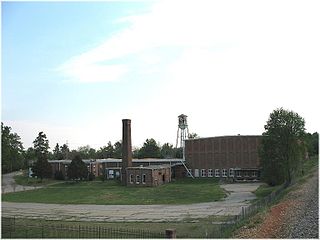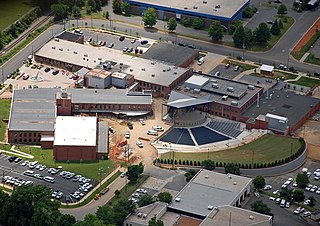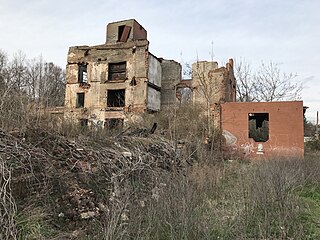
NoDa is a popular arts district in Charlotte, North Carolina, United States. It is located in the North Charlotte neighborhood on and around North Davidson Street and 36th Street, approximately one mile northeast of Uptown. Formerly an area of textile manufacturing and mill workers' residences, the area has also served as a center for the arts.

Chatham Manufacturing Mill was built by the Chatham Manufacturing Company. The former textile mill is located in Winston-Salem in North Carolina.

The Midtown Woodward Historic District is a historic district located along Woodward Avenue in Detroit, Michigan. Structures in the district are located between 2951 and 3424 Woodward Avenue, and include structures on the corner of Charlotte Street and Peterboro Street. The district was admitted to the National Register of Historic Places in 2008.

Klots Throwing Company Mill is a historic silk mill located at Cumberland in Allegany County, Maryland, United States. It was built in 1902–1903, and is a long two-story brick building with double-gable roofs and paired stepped parapets. An addition was built in 1909. It was operated by Gentex Corporation and closed in 1972. The building was subsequently used for storage. From 1988 until 2002, the north end of the building housed the Western Maryland Food Bank. The building will be converted to loft apartments.

The Nashua Manufacturing Company Historic District in Nashua, New Hampshire, is a historic district that was listed on the National Register of Historic Places (NRHP) in 1987. It encompasses an area just west of downtown Nashua, roughly located along the southern bank of the Nashua River, bordered on the west side by Mine Falls Park, on the south side by the Nashua River canal, up to Ledge Street, and from the east side by Factory, Pine and Water streets, up to the Main Street bridge.

Stuart Warren Cramer was an American engineer, inventor, and contractor, who gained prominence after designing and building near 150 cotton mills in the southern United States. He was the founder of Cramerton and became involved in the nascent air conditioning industry, as well as being a founding partner in Duke Power.

The North Charlotte Historic District is a 155.5-acre (62.9 ha) national historic district located in Charlotte, Mecklenburg County, North Carolina. The listing included 282 contributing buildings and four contributing structures. It includes work designed by architect Stuart Warren Cramer; it includes Bungalow/craftsman, Late Victorian, vernacular Victorian, reflecting turn-of-the-century mill-village architecture. Located in the district is the separately listed Highland Park Mill No. 3. Other notable buildings include the Mecklenburg Mill, Johnston Mill (1913), Grinnell Manufacturing Company, Hand Pharmacy Building (1904), Lowder Building (1927), the former Highland Inn, Charlotte Fire Department Engine Company No. 9 (1937), and North Charlotte Primary School.

Monaghan Mill, now the Lofts of Greenville, is a former textile mill (1900–2001) in Greenville, South Carolina, that in the early 21st century was converted into loft apartments. The building is listed on the National Register of Historic Places.

The American Tobacco Historic District is a historic tobacco factory complex and national historic district located in Durham, Durham County, North Carolina. The district encompasses 14 contributing buildings and three contributing structures built by the American Tobacco Company and its predecessors and successors from 1874 to the 1950s. Located in the district is the separately listed Italianate style W. T. Blackwell and Company building. Other notable contributing resources are the Romanesque Revival style Hill Warehouse (1900), Washington Warehouse (1902–07), the Lucky Strike Building (1901–02), and Reed Warehouse; Noell Building ; Power Plant and Engine House (1929–39); and the Art Moderne style Fowler (1939) Strickland (1946) and Crowe (1953) buildings.

Drayton Mill is a historic textile mill complex located near Spartanburg, Spartanburg County, South Carolina. The complex includes the distinctive Tudor Revival company store and office building, constructed in 1919. Other buildings and structures include the three-story, rectangular, red brick spinning mill (1902-1904) with later additions, a cotton warehouse (1918), a two-story weaving building (1928), a 1,500,000 gallon mill pond, two water towers, two pump buildings, and an information center.

Highland Park Manufacturing Plant and Cotton Oil Complex is a historic industrial complex and national historic district located at Rock Hill, South Carolina. It encompasses three contributing building and two contributing structures in Rock Hill. The complex includes the Highland Park Manufacturing Plant, the Highland Park Cotton Oil Mill (1902), and the Highland Park Cotton Oil Mill Office (1902). They are the surviving buildings of a larger complex, including a gin and seed house, the rest of which have been demolished. Surrounding the original mill are portions of the mill village. The mill operated until 1968.

Sterling Cotton Mill, also known as the Franklinton Cotton Mill, is a historic cotton mill complex located at 108-112 East Green Street in Franklinton, Franklin County, North Carolina. The main mill is a one and two-story L-shaped brick building with Industrial Italianate style design elements. The mill consists of five sections: the original gabled one-story section rising to a two-story section at the east end (1895); a two-story addition (1914), a one-story addition (1960s); pre-1926 "cotton sheds"; and a small two-story brick office (1966). Associated with the mill is the contributing detached chimney stack. The mill was built by Samuel C. Vann, whose son Aldridge built the Aldridge H. Vann House. The mill closed in 1991.

The Bessemer City Downtown Historic District is a national historic district in Bessemer City, Gaston County, North Carolina. It encompasses 23 contributing buildings and 10 contributing structures in Bessemer City's central business district. The buildings were built between after 1896, and include one- and two-story commercial buildings and two large, sprawling textile mill complexes. Notable buildings include:
Hoskins Mill is a historic cotton mill located at Charlotte, Mecklenburg County, North Carolina. It was built in 1903–1904, and is a rectangular brick building consisting of a three-story, main section with a one-story weaving room addition. The floor of the mill was used for weaving, the second for carding, and the third for spinning. Also on the property is a 1 1/2-story, rectangular brick office building. It was used as a mill through 1985.

Orient Manufacturing Company-Chadwick-Hoskins No. 3, also known as Alpha-Orient Cotton Mill, is a historic cotton mill located at Charlotte, Mecklenburg County, North Carolina. It was built in 1901–1902, and is a two-story, Romanesque Revival style brick building. It incorporates portions of an original mill building built about 1889. The building has a low, front gable roof with exposed rafters, brick exterior walls, and segmental arched windows. It features a three-story staircase tower with a castellated parapet, tall, narrow windows, and a round arched entrance.

Southern Asbestos Company Mills, also known as Fiber Mills, is a historic asbestos factory complex located at Charlotte, Mecklenburg County, North Carolina. The complex consists of two red brick buildings joined by a bridge section and constructed in phases primarily between 1904 and 1959. During the 1940s and early 1950s, R. C. Biberstein Company made some improvements and designed additions.

Franklinville Historic District is a national historic district located at Franklinville, Randolph County, North Carolina. The district encompasses 137 contributing buildings, 1 contributing site, and 5 contributing structures in the central business district and surrounding residential sections of Franklinville. It includes buildings built between about 1819 and the late 1920s and notable examples of Victorian and Greek Revival architecture. Notable buildings include the Franklinville Manufacturing Company complex, Johnson-Julian House, Horney-Curtis-Buie House, a group of antebellum mill houses, Madison Brower House, Hanks Lodge (1850), Frazier-Fentress House, Franklinville Methodist Church (1912-1913), Grove Hotel (1915-1919), and Franklinville Store Company (1920).

Kesler Manufacturing Co.–Cannon Mills Co. Plant No. 7 Historic District is a national historic district located at Salisbury, Rowan County, North Carolina. The district encompasses 109 contributing buildings and 1 contributing structure consisting of a complex of industrial buildings and mill dwellings. It largely developed between about 1895 and 1930, and includes notable examples of Gothic Revival and Bungalow / American Craftsman style architecture. Notable buildings include the Kesler Manufacturing Company/Cannon Mills complex (1895–1930), Kepley–Trexler House, Henry–Kesler Manufacturing Company House (1910), Kimball–Kesler Mill House (1916), and Morgan–Kesler Manufacturing Company House (1914).

Pilot Mill is a historic textile mill complex located at Raleigh, Wake County, North Carolina. The original building was built in 1894, and is a two-story, vernacular brick structure, 33 bays long and 7 bays wide. The upper windows are arched and the building has a three-story, square, corner tower. The building was extended sometime before 1903 and again prior to 1914. The other contributing buildings include the one-story dye house ; a two-story connecting structure ; and two-story, Classical Revival style office, shipping and inspection building. The mill operated until 1982.

The Coleman-Franklin-Cannon Mill is a historic industrial complex at 625 Main Street SW in Concord, North Carolina. The recognized complex consists of ten buildings on 6.6 acres (2.7 ha), about 2 miles (3.2 km) west of downtown Concord. Another 4.4 acres are not included. The oldest portion of the mill, now its eastern section, is a brick two-story structure 14 bays long and 9 deep. The historic site also includes some worker housing.























